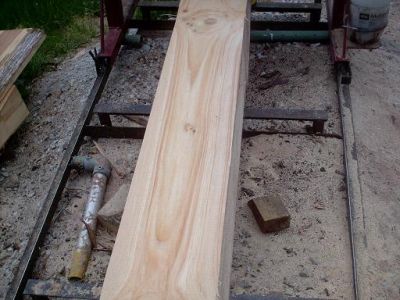Question
Am I right that you can not get all of the true quartersawn lumber out of a log without turning it (or at least turning the quarters)? I keep seeing swingers telling how easy it is for them to QS a log, but I think they are taking much of the lumber as rift sawn lumber, and calling it quartersawn.
Forum Responses
(Sawing and Drying Forum)
From contributor S:
I would like to know also. I have looked at this for some time and found a couple of points that kind of tilt the results when I draw it out. First, every log is different, but assuming a good round log, would you want to take the heart out as a cant or beam? Depending on the size, I think I would. If the log was quartered, you lose this. If the log is quartered first and then sawn for quartered lumber, each board has a beveled edge on the inside. The beveled edge is pretty much waste; a swinger leaves the inside edge square. From what I can tell by drawing it out, the yield of rift versus quarter look to be about the same. This is not a mathematical certainty, just my best guess. The square edge and a chance to take out a good center cant puts me in the swing mill camp. Of course there are other more labor intensive ways of getting the cant out and quarter sawing the surrounding log.
I "quarter" saw Douglas fir to get vertical grain lumber. It takes a fairly large log (40"+) to get good clear tight VG. Not much chance of rolling it around once the frame is around it. My market accepts up to about 60 degree slope of grain (rift sawn, if you will) toward the wide face, which still gives the appearance of VG. With that much leeway, I can "quarter" saw the whole log.
But the center is of little concern for VG grade lumber because of the knots and wider growth rings. But grade comes into play with beams because of a thing called FOHC (free of heart center). The most desirable beams and premium priced are FOHC, so that's where I try and take the taper out of the log. My understanding is that any board or beam that contains heart center will split. Boxing the heart center of smaller logs is a method of recovering more lumber with a so-so beam from the lower grade wood. I'd rather cut 2" X 4" and 2" x 6" from the center and sell them as construction wood.
I haven't cut any wood that requires you be dead on to get pattern, such as oak. That would be a different story and a learning curve for me. And it would also mostly mean smaller logs.
As you work across the log, the first boards will be rift sawn, then exactly qsawn, then back to rift again. This is slightly different to a bandmill where the log is quartered then the widest boards are cut out at exactly 90 degrees. After that, the boards get narrower and the angle drifts toward rift as the quarter log is sawn down.
However, neither mill will recover 100% quartersawn boards. The bandmill may be able to cut a few perfect wider boards if the log is big enough, but the later boards from each quarter will not be 90 degrees either. The swingblade is restricted to its 6/8/10" cut which can be a disadvantage, but the swingblade can qsaw a log with no extra work - it makes little difference to the operator if you cut an 8x1 or a 1x8 board from that location in the log.
The only way to get all qsawn boards is to radial saw, where the log is sawn up like slices of a pizza. This, however, is very wasteful, as the boards come out triangle shaped and have to be resawn/edged again. Although you have all prefect qsawn boards, half the log is in the waste pile.
